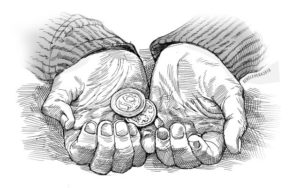
In the Brooklyn Museum hangs a watercolor painting by James Joseph Jacques Tissot, a French artist who lived towards the end of the twentieth century.
It depicts a scene that Mark writes about in his Gospel, in which Jesus was observing the people putting in their money, many of them in large sums, into the temple treasury.
He noticed a poor widow approach and drop into the treasury two small coins — equivalent in value to the least of the Roman coins.
Jesus called his disciples and told them, pointing to the widow, “Amen, I say to you, this poor widow put in more than all the other contributors to the treasury.
For they have all contributed from their surplus wealth, but she, from her poverty, has contributed all she had, her whole livelihood.”
Tissot’s painting shows a shabbily dressed woman holding a child standing in front of the collection box.
She seems to have just put in her small coins, all that she had.
Her face, drawn and haggard, is the face of poverty.
Somewhat in front of her, to the left, watch two men, likewise of humble circumstances.
Behind her, emerging from a door and moving towards the treasury box, are three well-dressed gentlemen.
At the back, a white-clad Jesus sits, talking to three of his disciples, motioning towards the woman.
The story is often used to illustrate the nature of giving, the bigheartedness of which finds measure, not so much in the value of the thing given as in its value to the giver.
To the wealthy the big amounts that they put in, drawn from their surplus, have only a fiscal, and a proportionally negligible worth, while the widow’s two small coins, extracted from her need, have an existential, and a deeply spiritual value.
Sacrificing one’s life for others would not mean much if one had several lives to spare.
Jesus had earlier condemned the scribes for, in his words, devouring the houses of widows.
Hence, while praising the generosity of the poor woman who deposited her last coins into the treasury, Jesus in fact attacked the Jewish authorities for abetting donations from even so destitute a class as widows.
Jesus seemed to say, “Look at that poor woman, how generous she is, and how greedy are those who require people like her, who have next to nothing, to contribute even the little that they have.”
Tissot stuck to a realistic style despite being surrounded by artist friends from the Impressionist School, and, especially after the death of his lover and muse, found solace in his Catholic faith and turned away from depicting fashionable women in favor of biblical scenes.
In the painting of the widow, I sense the artist’s faith which allows him to draw from this Gospel event its genuinely human and spiritual dimensions.